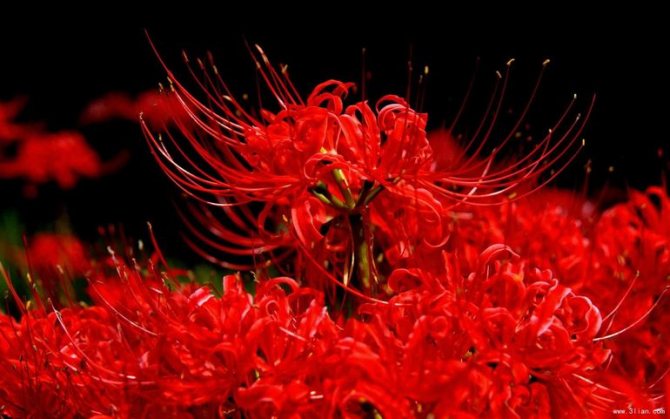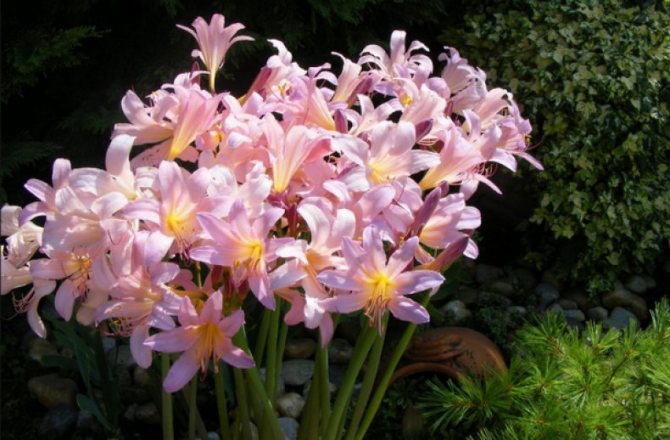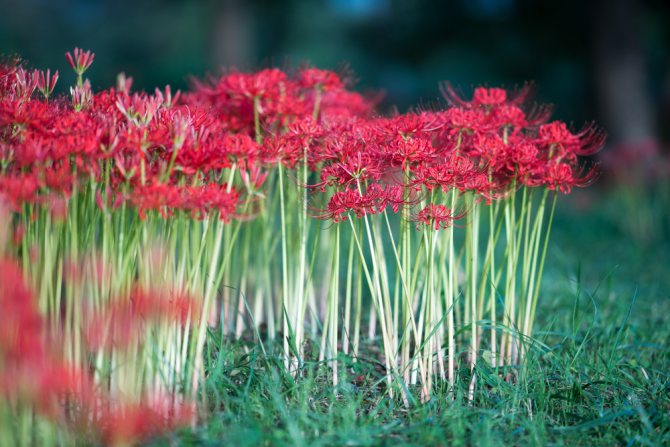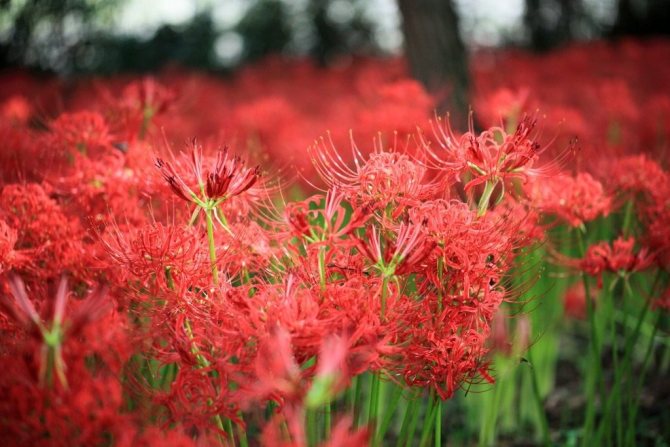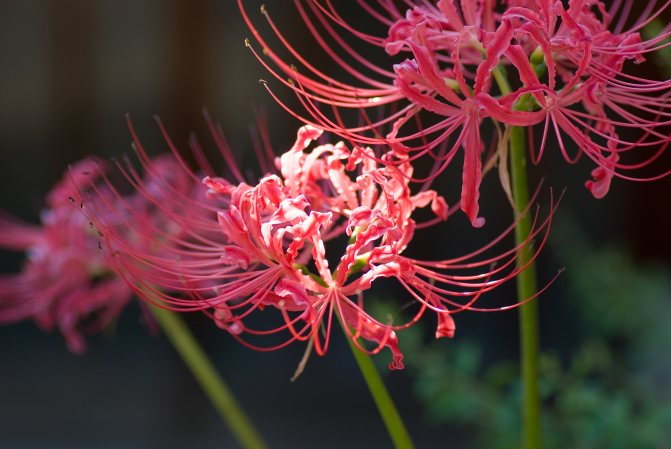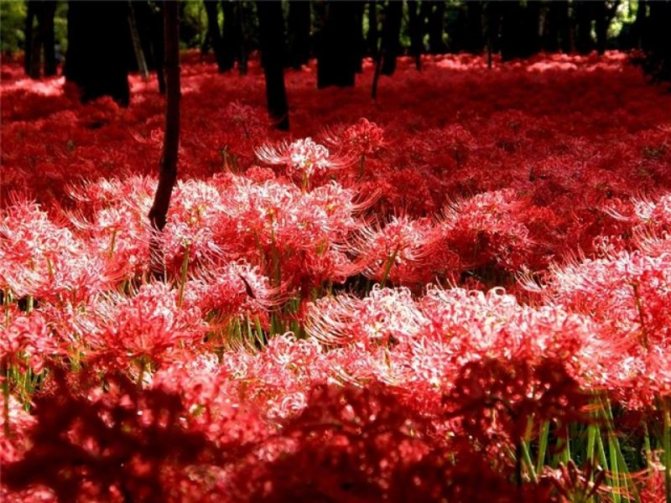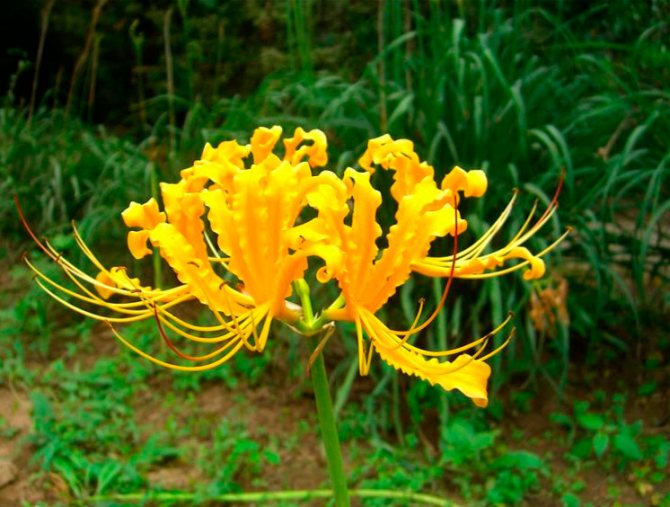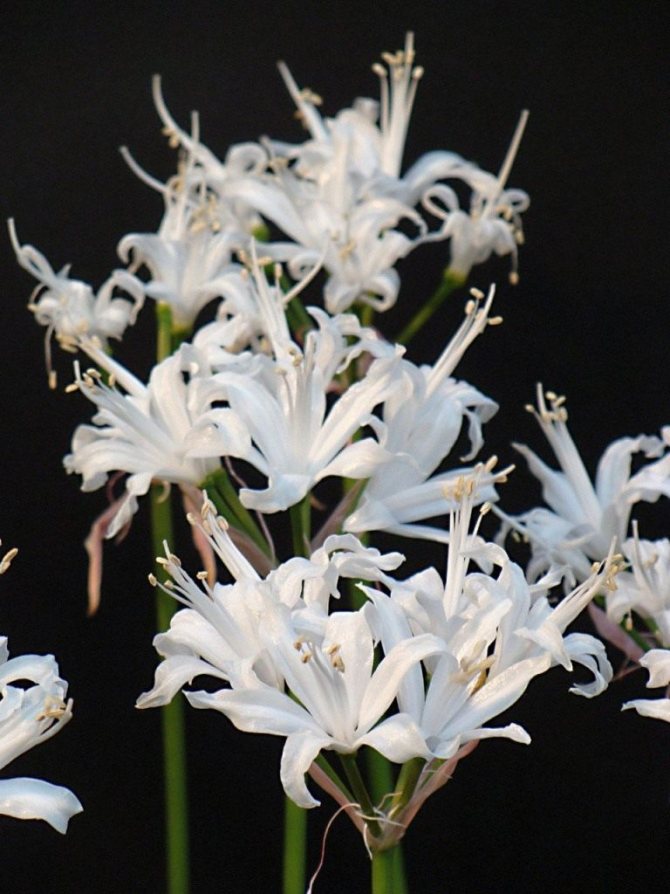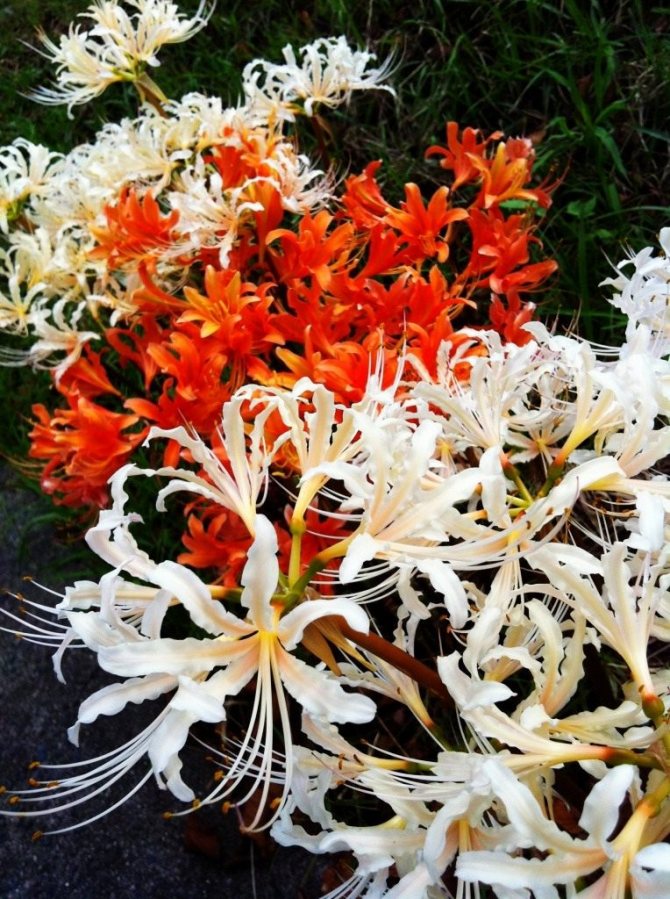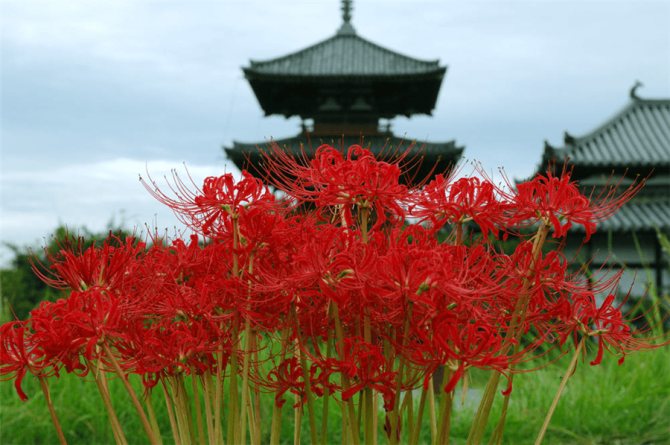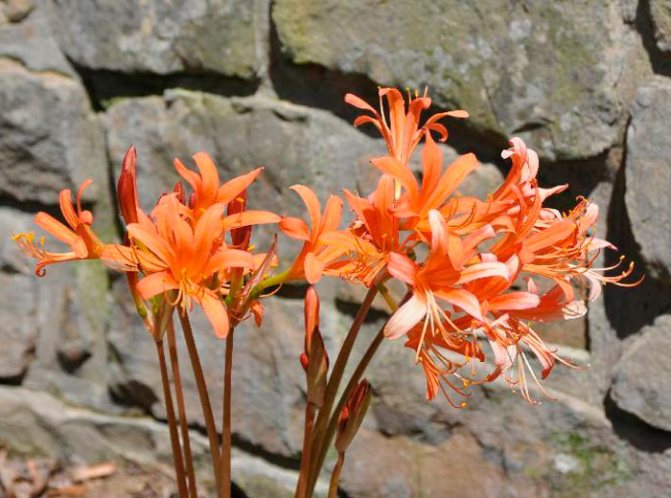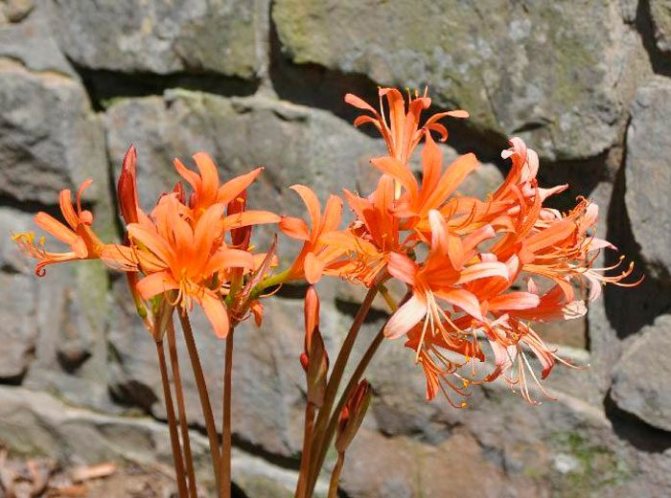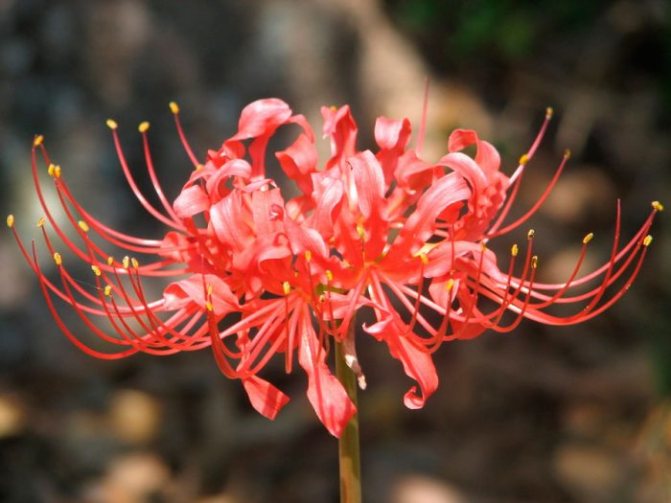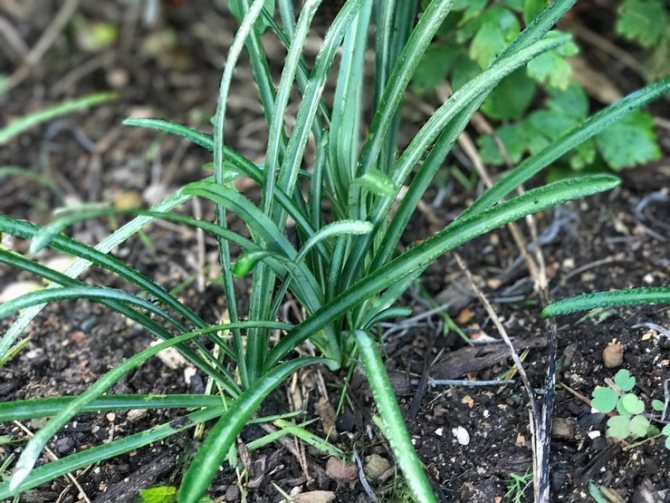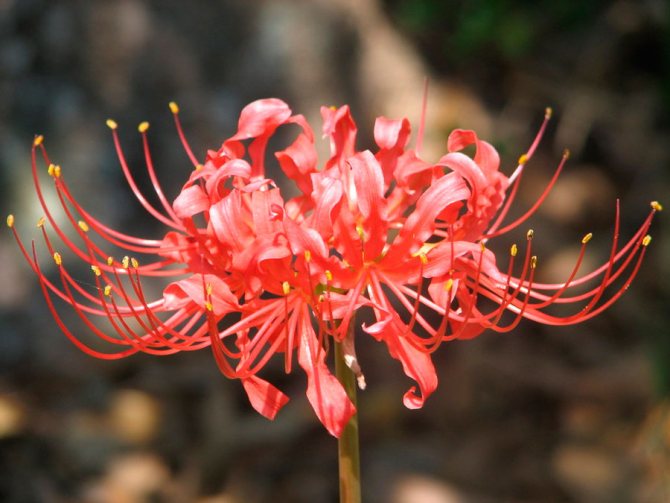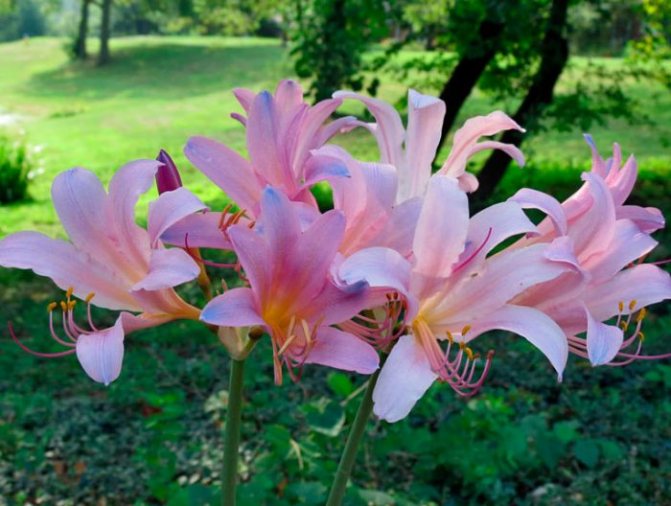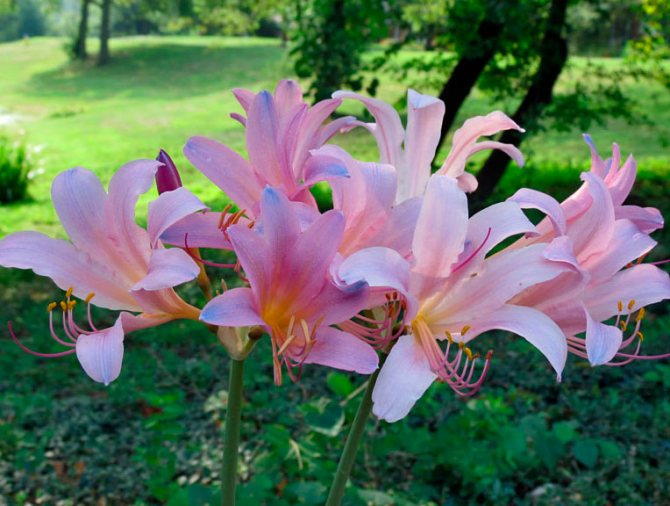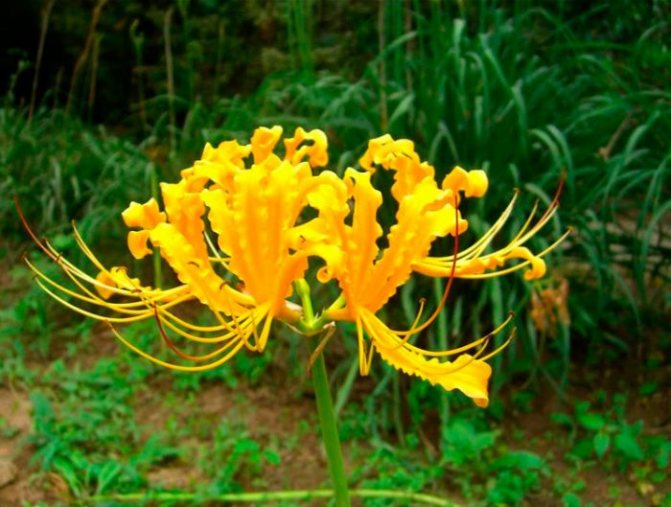Licoris (from Latin Lycoris) is a perennial flower bush, which is popularly called a spider lily. The flower is characterized by an exotic appearance, due to which it has found decorative use in gardens and parks of florists. Lycoris is also grown as a houseplant. Due to the peculiarities of the growth of the flower, various legends are formed about the licoris.
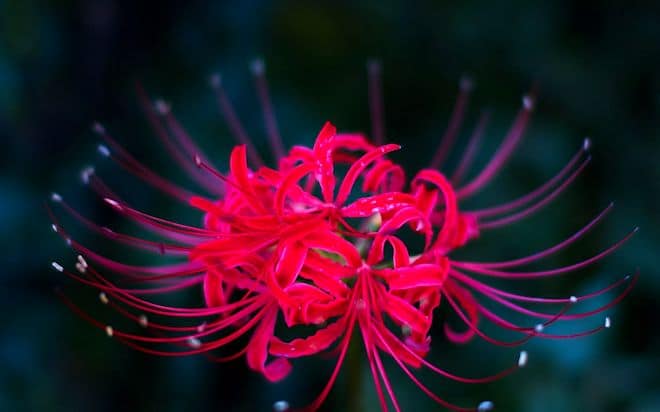
Botanical description of the plant
Licoris is a bulbous representative of perennial plants that belong to the Amaryllis family. the peculiarity of the flower is the unusualness of its life. So, during the season, the plant goes through two periods - flowering and landscaping. At the same time, at first the flower is greened, and as soon as the first peduncles appear, the foliage falls off and flowering begins. After the formation of dry peduncles, the plant is greened again.
In the people of Asia, the plant has a negative meaning, therefore it bears a large number of names - heavenly flower, fox flower, demon lily, hellish flower.
Licoris is a tall plant that reaches a height of one meter. Lycoris root is represented by a bulb, which absorbs nutrients from the soil and directs them up the stem. The bulb is a dense spherical structure, black or brown in color. The diameter of the bulb in an adult culture reaches 5 cm. The root surface is covered with scales, like that of a tulip. After the leaves die off, a stem emerges from the base of the bulb. The stem is erect, a thick, cylindrical bundle up to 90 cm in height. The surface of the stem is bare. Peduncles are formed at the end of the stem.
The lycoris leaf plate is an elongated structure. The leaves are smooth to the touch, with smooth edges. The width of the leaf plate does not exceed 5 cm, however, individuals with wider leaves are found. Leaves are pointed to the edge. Due to their length, the sheet plates cannot support their own weight, therefore, as they grow, they bend back and slope towards the ground at the edges. Licorice is decorative due to the fact that the abundant amount of leaves gives the flower the appearance of a lush bush.
By mid-July, the leaves begin to dry out and fall off, after which a long stem appears, which acts as a peduncle. At the end of the stem, by the beginning of autumn, an inflorescence of 6-7 buds is formed. The petals on the inflorescence are elongated flat-shaped plates, the edges of which are rounded in different directions. Lycoris blooms in autumn. The shade of inflorescences in different species is red, orange, white, yellow. There are varieties with pink colors.
The inflorescences bloom in various shades of six-petalled funnel-shaped flowers. flowers are arranged in groups, several inflorescences on one stem, due to which they look unusual on the bare background of the stem. The inflorescences have a pleasant, delicate scent that attracts insects. The culture is pollinated with the help of insects that transfer pollen from one plant to another.
Different types of lycoris have different inflorescences - on some the stamens and pistils are the same in size, in others they exceed the length of the petals.
After flowering, a small fruit is formed on the peduncle in the form of a box with seeds. The seeds are elongated and black. Three-section boxes.One fruit contains a small amount of seeds necessary for the reproduction of lycoris.
Your browser is not supported
Previously, Hide thought that touching the kagune ghoul was only possible in two cases. When you chop it off with your queen - an option suitable for experienced investigators who are adept at fighting the eternal opponents of humans. Or when the kagune is wrapped around your body, which, according to all signs, guarantees a quick death. But he and Kaneki are a special case. Kagune Kaneki blooms like a flower. Looks like a lycoris, Hide thinks when he sees it for the first time. Lycoris or spider lily is a flower that grows along the road leading to the world of the dead. For those who walk it, there is no turning back. There is no escape route for Hide either. He gave up his old life without hesitation, like a bride escaping from under the crown with an unlucky groom. Until recently, he had a good job, a place at a prestigious university, a house where you can return at any moment. He traded all this for the opportunity to fall asleep and wake up with his best friend. To be honest, they were one step away from becoming lovers, although they slept in the same bed not for romantic reasons. In this small house, where Kaneki lived with his strange (Gang? Company? Alternative Swedish family?) There were too many ghouls and at least one of them was badly controlling himself. Hide did not understand what motives Kaneki had for allowing Tsukiyama to stay with him. Tsukiyama was less useful than a Google translator, and in terms of noise and inconvenience, he was comparable to a restless baby blowing bubbles at a neighbor in a chair during a long flight. At the sight of Hide, Tsukiyama made a small theatrical hysteria. He was very much outraged by the fact that a weak person would live with them, who, moreover, (such an infection) is dear to Kaneki. Much dearer than his Excellency Tsukiyama, polyglot and mod. It was then that the question was raised about the hunger of the ghouls and the unpredictable consequences that threaten to turn into a real tragedy. Hide didn’t like the fact that in his new home he was treated like a delicious dessert hidden in the refrigerator until the night, but when Kaneki said “don’t worry, he will sleep in my room, I can protect him”, the desire to object instantly disappeared. The gray-haired, unusually calm and incredibly strong Kaneki seemed to Hide a stranger, and he was ready to seize on any opportunity leading to their rapprochement. Hide refused to believe that the former Kaneki, his dear Kaneki, had disappeared forever. He was somewhere out there, behind a snow-white wall, in a scarlet field covered with lycoris flowers. It was not worth destroying this wall, it was impossible to bypass it, but it was necessary to get to the other side. When he and Hide were alone, Kaneki's gaze grew noticeably warmer. But it took several days before Kaneki succumbed to his persuasion to demonstrate to the kagune. “It's dangerous,” he said. - I am not always in control. - When you yourself are in danger! And now everything is fine, besides, we are not alone here, I will definitely have time to scream or run out of the room if something does not go according to plan. - Hide, but it looks ... creepy. - Kaneki resorted to other arguments. “You’ll start to be afraid of me. - I won't start. I saw your kagune the day Nishiki attacked us, and nothing, I continued to communicate with you after that. - Do you remember what happened in that alley ?! Kaneki was seriously dumbfounded by this news. “Even so, my kagune didn’t look as bad at that time as it does now. - Kaneki! We are not in a beauty contest, but I have strong nerves. Such pointless arguments helped them while away the time. When Hide realized that even today he would have to retreat without having achieved anything, he sighed heavily and turned his back to Kaneki, knowing that it would not be long before Ken pressed himself against him, nuzzling his shoulder.Kaneki did this unconsciously as soon as he fell asleep. Maybe he only comes back when he sleeps, Hide thought bitterly. But not only did he not want to retreat, he could not. It would have nullified all his previous efforts. When Kaneki finally succumbed to his persuasion, Hide felt like a commander who won the first major victory. Kagune Kaneki resembles not only a flower, but also the tentacles of some outlandish insect. It is very difficult to believe that this is now also a part of Kaneki's body, not something alien, not a disease eating him from the inside. It's hard to believe that Kaneki can control him. Of course, Kaneki doesn't show him the kagune in all its combat glory. If its tentacles were as huge as in the alley where Hide's life almost ended, they would have to say goodbye to the bed forever (along with other pieces of furniture). The quivering red tentacles are now half the size of their owner. Hide looks at him and with no logical reasoning can not get rid of the thought that someone else's kagune is also looking closely at him, like wild animals looking at people who have entered their territory. Food? Friend? “Be careful,” Kaneki asks in a strained voice as Hide reaches out to one of the red appendages. He is more afraid than Hide. As a person who does not know how to measure his strength, and does not want to harm other people. Hide strokes the tentacles (petals) of the kagune with his fingertips. The tentacles twitch nervously in time with his movements, like a cat's tail. But the shine does not emanate from the cat's tails, and the kagune flickers so brightly that it can be clearly seen in the dark (it is reasonable, because ghouls most often go hunting at night). Shimmers, shimmers, changing color from crimson to bright scarlet. Hide thinks that Kaneki can read books by the light of his own kagune, and smiles as he imagines how ridiculous it would look. Tentacles that turn pages. - See? He says. - Nothing terrible happens. - Okay. Kaneki is still wary, thinking tensely about something. A few seconds later, Hide finds out exactly what he was thinking about. Obeying the will of the owner, the tentacles of the kagune suddenly twine around Hide's waist and squeeze slightly, as if embracing. Hide gasps in surprise, and the tentacles immediately release him, but he manages to grab one of them, holding it, pressing it to his stomach. - Sorry Sorry! - whispers to Hide fervently. “It didn't hurt at all, do it again. - Do you really want this? - Exactly. The tentacles return, hugging him a little tighter than the first time. Living warmth emanates from them. They say that a hug that lasts longer than thirty seconds is awkward, but Hide feels confident and calm, being in the center of a scarlet ring, pulsing in all shades of red, and does not want to change anything. - Aren't you scared at all? - asks Kaneki, looking at him from the darkness, from the other half of the bed. Flashes of red play on his face, too. - Not. I think they are very beautiful, ”Hide replies sincerely and strokes the tentacles again, one by one, so that no one is offended. “Thank you,” Kaneki says, moving closer, “that you're not afraid. That ... - he hesitates, probably choosing in what tone to say the next words - that you love me. As a friend? No further explanation follows. - There is nothing difficult in this. I love you since childhood. From the first day of our acquaintance, I understood that you are not like the others. Hide knows that it almost sounds like a declaration of love. Why not? He is in the arms of a kagune, he was brave enough today to continue in the same spirit. “You, too, have never been like everyone else,” Kaneki replies quietly. They had spoken in whispers before, so as not to wake anyone, but now the whisper sounded somehow different. The intimacy inherent in any conversation about feelings appears in him. - Really? I distinguished myself only by being the first to approach you. - Not only. Hide, you are wonderful.- We are both cool, what is really there…. - obeying his desires, Hide bends down and touches the tip of one of the tentacles with his lips. This is the strangest first kiss they could ever have. That's right, because they are a special case. Kaneki closes her eyes and sighs softly. The tentacles twitch more quickly as he clenches his fists, crumpling the sheet in his fingers. - You like it? - asks Hide, despite the fact that he already found out the answer, and repeats his insidious trick with kissing. According to him, kissing a kagune is like kissing someone's hand. “Very,” Kaneki says, embarrassed. “Probably no one ever does that to a kagune. I had no idea that it would be nice. - You can do something else with him. Being in the grip of unbridled courage, Hide decides on a very frank act. He wraps his hand around the tentacle, pulls to his mouth and runs his tongue along the bright red tip. His heart at this time is beating furiously in his chest. “And this is… strange. It tickles ... - says Kaneki in an unusually high, breaking voice. As if he recently ran a long relay race and now cannot catch his breath. The tentacle that Hide is still holding in his hands noticeably hardens, evoking associations with a completely different organ, not intended for murder. Now you won't be able to bite - Hide thinks not without regret, but quickly finds an alternative. Struggling with his own arousal, which makes it difficult for him to plan and in general somehow monitor his actions, Hide takes the tip of the tentacle in his mouth and begins to suck it. Slowly, while monitoring Kaneki's reaction. You don't have to wait long for a reaction. Kaneki lets out a gasp and then groans. The remaining three tentacles, still wrapped around Hide's waist, immediately begin to move. Not having time to understand what happened, Hide is pressed against Kaneki, so closely that their noses touch. The tentacles of the kagune join above their heads like roses close their petals at nightfall. It's time for a real first kiss.
Spread
Licoris is an oriental plant that occurs quite often in its natural environment. It grows mainly in Asian countries - in the People's Republic of China, Japan and Thailand. Some varieties can be found in the south of Korea, Afghanistan and Vietnam.
Today, lycoris is cultivated, so it is possible to grow it without any problems in any part of the world. So, you can find varieties in South America, the European part. At home, it is possible to grow a spider line, like potted plants.
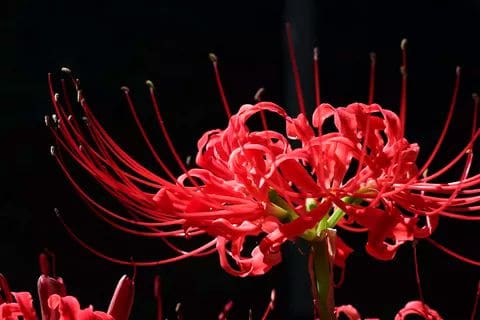

Landing
Planting lycoris in general terms is similar to planting other bulbs, but has several individual features.
Time
It is preferable to replant this plant in the fall after the flowering of the mother specimen is completely completed. At the same time, planting material appears on sale. To take root and adapt in a new place, this representative of the flora will need at least 5-6 months, which fall in the winter. In the spring the plant will begin to develop, and will show its first flowering in the summer.
Sometimes planting is carried out in the spring. This should be avoided, since the number of established specimens is much lower compared to the autumn planting. Flowering in this case will come only after a year.
From the set planting time, you can retreat in case of need for emergency assistance to a sick flower: if it is affected by root parasites or withers before the due date due to waterlogging. In this case, its corms are immediately dug up, treated in the necessary solutions and transplanted into a new place that is not infected with parasites or bacteria.
Seat selection
The plant needs bright light, but direct sunlight has a detrimental effect on it, so diffused light in partial shade conditions would be ideal.To do this, choose the north side in the garden or areas under small and not dense trees or bushes. In such a place, one more condition necessary for growing will be observed - the temperature will not rise more than 27 ° C, which is necessary in order for the flowers to remain open longer.
If the culture is grown at home on a windowsill, then in the spring it may lack natural light. Then an additional source of illumination should be provided in the form of a fluorescent lamp or phytolamp. Otherwise, the peduncle may not form. It's great if you can put the pot in the yard or on the balcony for the summer.


The soil
Prepare the soil before planting. Some gardeners prefer not to bother themselves and purchase soil for bulbous crops, but it is not difficult to prepare suitable soil on their own, and lycoris will develop even better in it.
The basic requirements for the soil for this plant are that it must be permeable to water and air, and must also contain a sufficient amount of nutrients.
To prepare the soil, you need to take the following components:
- leafy land;
- red peat;
- coarse sand.
All components are taken in the same amount and mixed until smooth. To protect the plant from fungal diseases and parasite larvae, the mixture can be calcined in the oven for an hour. For flowers that will be planted in the open field, such disinfection is usually not carried out.
Types and varieties of lycoris
To date, there are about 20 species of lycoris. Many varieties are cultivated and hybridized, so they can grow indoors. However, only a few varieties are very popular with flower growers.
Licoris golden lycoris aurea
Representative of the eastern part of the world. In its natural environment, the plant is found in China and Japan. This is a thermophilic plant that does not tolerate frost well. Therefore, in garden conditions, the plant is rarely grown. The maximum possible temperature that golden licoris can withstand is 5 degrees below zero. This condition allows you to grow a plant in the garden in the summer, if you bring the flower indoors for the winter.
Golden Lycoris is a fairly tall plant that reaches half a meter in the stem. At the same time, the diameter of the rosette of leaves does not exceed 20 cm. The leaves are predominantly light green, elongated. In shape, the leaf plate resembles tulip leaves.
A feature of the spider lily is the rich yellow flowers that appear on the stem towards the end of spring. Lycoris blooms for several weeks, after which it dies. The flowers are funnel-shaped, with narrow, curving leaves. Up to 6 flowers can grow on one inflorescence, each bud up to 5 cm in diameter.
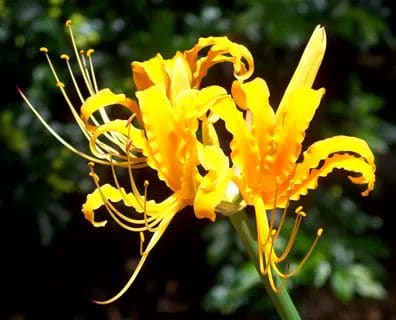

Licoris scaly lycoris squamigera
It grows naturally in Japan. Cultivated varieties feel good enough in the middle lane, but they must be grown at home. Licorice scaly is a tall plant that can reach 0.7 m in height. The root rosette at the base is about 30 cm in diameter and forms a lush bush of leaves.
Leaves are bright green, elongated. The length of each sheet plate reaches half a meter. At the same time, the leaf blade of the spider lily is rather narrow, not exceeding 4 cm in the center.
As the foliage dies away by the end of summer, up to 7 stems appear on the lycoris, at the top of which about a dozen buds with inflorescences appear. Lycoris blooms for only half a month. During this time, the buds replace each other about 2 times. The flowers of the scaly spider lily are predominantly lilac shades, however, there are specimens of light pink tones.The inflorescence petals are elongated and rounded, forming a bell-shaped flower with petals bent back. The diameter of each inflorescence does not exceed 5 cm.
After flowering on the pedicels, fruits are formed in the form of boxes with seeds, which perform the function of reproduction.
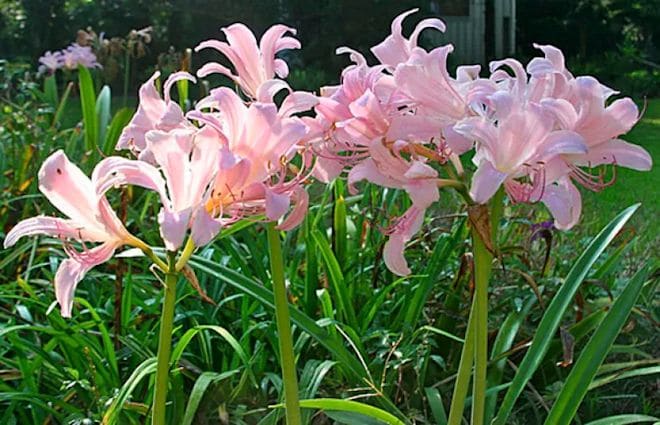

Blood red lycoris lycoris sanguinea
The smallest representative of Lycoris. The height of the bush formed from the root rosette of leaves is only half a meter. At the same time, a feature of the variety is a fairly rapid yellowing and shedding of leaves.
The leaves of the species appear in mid-spring. The leaf plate is narrow and long, no more than one and a half centimeters wide. The edge of the sheet is even, pointed towards the end.
Inflorescences appear after the lycoris foliage turns yellow, towards the end of summer. At the same time, several small buds appear on long peduncles, reaching only half a centimeter in diameter. A feature of the plant are bright red, rich flowers, thanks to which the flower got its name.


Licoris radiant
A fairly common species that can be found throughout the eastern part of Asia and Europe. A feature of the variety is the late appearance of leaves, which grow into a root rosette after flowering. Thus, the life cycle of a variety is the opposite as compared to other varieties.
The plant is perennial, tall. The height of healthy adult bushes exceeds 70 cm. At the same time, the leaves of the lycoris are narrow, up to a centimeter wide. Often the leaf blade does not support its weight, so the narrow and long leaves sag under the weight of the weight towards the ground.
The plant blooms in early summer with bright purple, white or red flowers of large diameter. The peduncle is leafless, growing up to 70 cm in length. The stem of the plant is thick and fleshy, allowing you to keep the flowers upward. The plant is especially due to its unusual flowers. The first row of petals in the inflorescence is elongated, bent back. Towards the center of the flower, the petals become smaller and form wavy shapes, often intertwining with each other.
Another feature of the variety is the absence of a seed reproduction method. If necessary, it is possible to breed the number of species only vegetatively. After flowering, leaves appear on the flower.
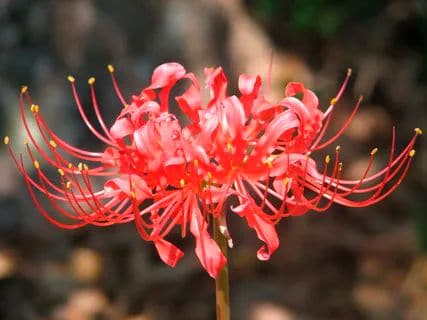

Plant care
Spider lily care is easy. This is a rather unpretentious plant that has been compared to daffodils and tulips. However, it is important to remember that not only the duration of flowering, but also the life span of a perennial depends on the quality of care and on the preservation of growing conditions.
An important point in growing lycoris is the right place for the plant. For full-fledged growth and reproduction, the flower is provided with conditions that are as close as possible to its natural habitat. When growing crops in indoor conditions, a large number of rules should also be followed.
Lighting
Lycoris prefers bright, sunny places. In its natural environment, it grows in open areas. The plant thrives in partial shade, under the crown of trees or bushes. Licoris is photophilous, therefore, in conditions of artificial cultivation, an adequate supply of light to the foliage should be ensured.
If the spider lily is planted at home, you need to put the pot in a bright oriental room, with enough diffused sunlight. For optimal and long-term flower growth, if necessary, the amount of light is increased using artificial lamps.
Licorice badly needs lighting at the time of the formation of new foliage. Therefore, in early spring, when the sunlight is not bright enough, the flower is kept under artificial lamps for most of the day.At the same time, it is necessary to avoid exposure to very bright light on the leaves in order to prevent burns. The optimum distance of the lamp is about 10 cm from the edge of the sheet.


Temperature
The spider lily is a thermophilic flower that cannot withstand frost and strong winds. When growing lycoris in the garden, it is necessary to provide the plant with a constant temperature of at least 19 degrees. The most comfortable temperature is not higher than 27 degrees, since in hotter climates the lycoris begins to dry out and lose foliage.
When grown in open beds or gardens, the plant is protected from drafts and winds, since the spider lily does not tolerate such conditions.
In indoor growing lycoris, the air temperature should not be more than 20 degrees. Therefore, the flower is often placed on balconies or verandas in order to create conditions for a normal life.
Air humidity
Licorice is grown in warm climates with a lot of moisture. Therefore, an artificial room or open area must meet these conditions. With a small amount of moisture, the plant begins to wither and dry quickly. At the same time, excess moisture in the air also does not favor the optimal growth of lycoris. The optimum room humidity is 50%.
To create growing conditions, the spider lily is regularly sprayed with a spray bottle. In addition, a container with water is kept next to the pot so that the fumes fall on the flower.
Top dressing
The soil in which the spider lily is grown must contain a sufficient amount of fertilizer. Therefore, before planting the bulbs, the soil is fed with the help of complex fortified fertilizers, which can be easily purchased in stores.
The plant should be fed regularly as it grows. For optimal foliage development, top dressing is applied to the soil near the flower. Fertilization of the soil should be carried out at least once a month. If the flower looks lush and healthy, then the frequency of feeding is halved.
Watering
Licorice prefers moist, but not too damp soil. Therefore, it is necessary to constantly water with a moderate amount of water so that the soil does not dry out completely. It is important to prevent excessive stagnation of liquid in the soil to prevent bulb rot. In order for the water to saturate all the roots and the bulb, the surface of the soil is regularly loosened, passing oxygen to the roots.
Watering is necessary at least twice a week. In this case, the water is directed to the soil next to the bulb. Watering decreases as the plant changes its life cycle. So, when the lycoris leaves during hibernation during the change of foliage to flower stalks, watering is carried out 2-3 times a month. Watering is also reduced in winter.
The soil
Licorice grows naturally in loose sandy soil. Therefore, when planting it in garden or indoor conditions, you should prepare a substrate that is as similar as possible to a natural mixture for the growth of lycoris.
The substrate for growing lycoris must be nutritious and loose. A large amount of air must enter the soil, therefore a large amount of drainage must enter the soil. To do this, you can purchase a special soil mixture for flower plants in the store, add peat mixture and humus to it.
Some growers mix sand, peat, humus and drainage on their own, creating optimal conditions for the spider lily. The soil should be light enough to give the roots optimal growth space.
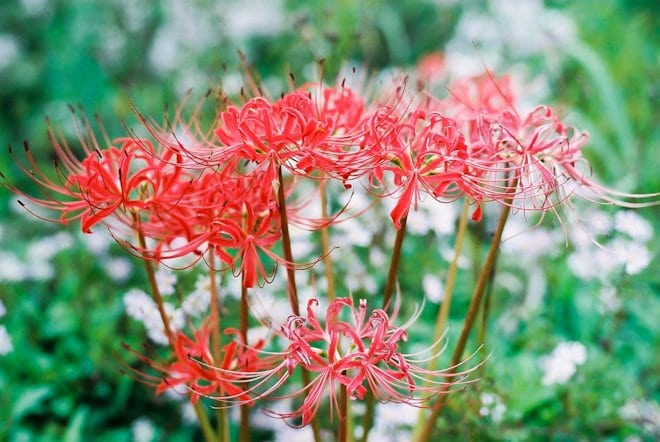

Transfer
Licorice is rarely transplanted, since with optimal fertilization and feeding it can exist in one place for up to 5 years. Therefore, there is no need to constantly replant lycoris. In the event that a need arises or a five-year period has passed, the flower bulbs must be transferred to a new place.
In order to transplant the lycoris painlessly for the plant, it is necessary to prepare in advance a new potting soil mixture in a pot or a place in the garden. You should also dig holes for the bulbs before digging up the plant and water them with water. After that, the bulbs of the plant are taken out of the ground along with a lump of soil. It is necessary to clean the bulbs from the remains of the earth with your hand as much as possible, without damaging the roots of the plant. before planting, it is necessary to divide the bulbs into sections. The places of fusion of the divisions and the main onion are treated with a weak solution of potassium permanganate or charcoal.
Planting of cuttings and bulbs is carried out in the fall, before the plants go into hibernation. At the same time, the plant may stop blooming for 1-2 seasons, since the bulbs must strengthen and gain strength. Transplanting too often is dangerous for the lycoris, since it weakens greatly, there is a high probability of death of the individual.
Pruning
To preserve its decorative appearance, the plant should be cut off. The manipulation is carried out in the fall, when dry peduncles and leaves remain on the bush. At the same time, the trimmed parts of the plant create additional shelter from frost.
After flowering
Leaf plates begin to form on the plant after the flower dries out. In this case, it is necessary to cut off the dry parts. After the end of flowering, the bulbs are not dug out, but buried in deeper layers of the soil. In addition, well-rooted bulbs are frost-resistant. To warm the soil and prepare the plant for winter, it is necessary to cover the place where the bulb grows with a thick layer of foliage, sawdust or spruce branches. At the beginning of spring, this layer should be removed to ensure normal growth.
Dormant period
Lycoris leaves during the dormant period twice - during the change of leaves to flower stalks and for the winter. In the first case. The plant does not require additional care, since the period takes place in a normal climate and conditions.
The most important point is the preparation and care of licorice in the winter. After the onset of frost and drying of the fruit with seeds, the plant goes into hibernation. As mentioned above, spider lilies are not dug out of the soil under open growing conditions, but covered with a layer of insulation.
At home growing after flowering and ripening of the fruit, lycoris must be prepared for hibernation. To do this, gradually reduce the frequency of watering and the time the plant is in the sun. Towards the onset of frost, the pot is taken to a dark, cool place and left in this form until spring.
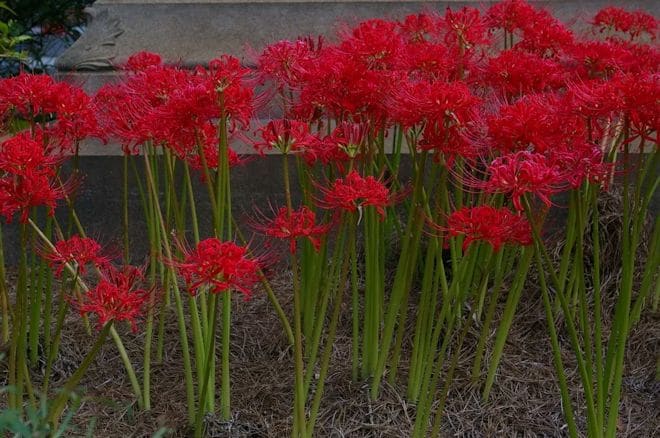

Sternbergia, or autumn daffodil
Sternbergia, or autumn daffodil, is a thermophilic bulbous plant and grows only in warm countries: Cyprus, Morocco, Turkey. Sternbergia blooms in late autumn at the end of October. On one peduncle of sternbergia, up to 10-13 flowers of a bright yellow, lemon color with a very delicate aroma bloom. Sternbergia flowers are very similar to crocus flowers.
Sternbergia leaves are dark green, shiny, very dense, grow very late, during the period of mass flowering, forming a solid bright green shiny carpet by January, which does not lose its decorative effect until mid-spring.
Sternbergia lukavitsa have a wide-rounded shape, up to 4 cm in diameter, they form a lot of daughter bulbs. Reproduction of sternbergia is only vegetative due to daughter bulbs, seeds are not tied.
Sternbergia colchiciflora (Sternbergia colchiciflora) is found in the Caucasus, in the southern countries of western Europe, as well as in southern Russia - in the Stavropol Territory, Krasnodar Territory, and Chechnya. Sternbergia grows in mountainous areas, rising to a height of 200 meters above sea level, preferring stony or dry clayey places. Sternbergia kolchikotsvetnaya is on the verge of extinction and is listed in the Red Book of Russia.
Planting lycoris in the open field
Growers often plant licoris outdoors, as spider lilies look great in open flower beds and gardens, among other flowers.
What time to plant
Lycoris is planted in mid-autumn, before the onset of permanent frosts. This is enough time for the bulbs to take root and take root. It is possible to plant a plant in open ground in spring, but the plant will not bloom for a long time.
Landing rules
The flower takes root well in sandy and peaty soil. Before planting, you should prepare and thoroughly loosen the soil, fertilize the soil mixture with fertilizers and humus. Licoris is planted on a flat surface, cleared of weeds and pests.
Bulbs of adults contain dark sides on the surface, which should be dug in with a layer of earth, at least 15 cm thick. Planting is carried out in moist soil. It is necessary to maintain a distance of at least half a meter between the bulbs in order to avoid crossing and displacement of individuals.
A layer of drainage and sand is placed at the bottom of the hole, into which the flower is planted. When planting, the bulb should be slightly pressed into the soil substrate so that when it is added, the bulb does not overturn. After planting lycoris, the ground is slightly crushed from above. In this state, the bulb hibernates and takes root. With optimal growth and development of roots, flowers appear on the culture in the second year after planting.
Planting bulbs: timing, pattern and depth
Licoris is the owner of rather large bulbs with a diameter of about 5 cm, covered with brown scales. Such impressive dimensions dictate the landing rules:
- bulbs of golden amaryllis must be planted at a depth of 14 cm in order to protect them from freezing;
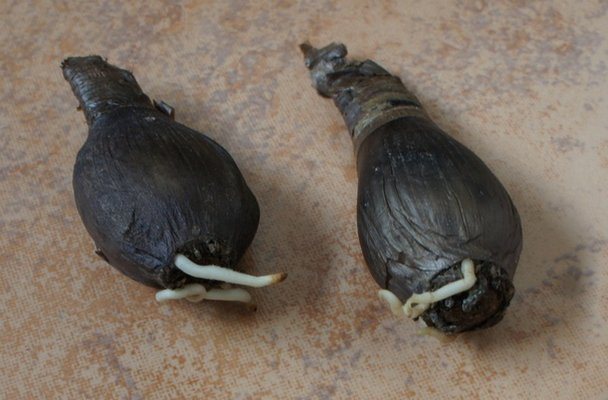

- a distance of 25-30 cm must be observed between each bulb, since every year the rhizomes multiply, and children appear;
- planting bulbs is recommended in the fall, as they need to adapt and take root. Spring plantings take root, but it is very painful.
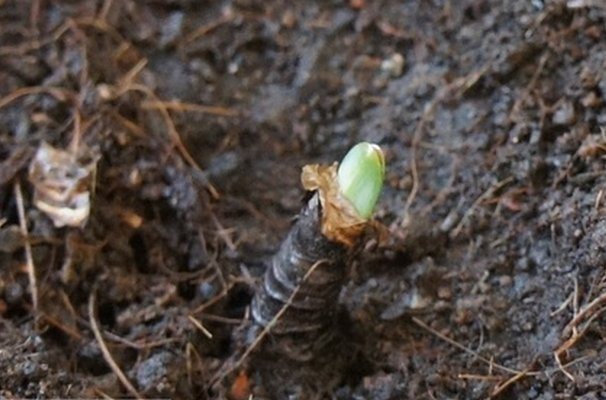

Important! You should not wait for the flowering of the spider lily the next year after planting - it is quite moody.
Reproduction of an ornamental plant
It is quite easy to propagate licoris in a vegetative way, since the bulbs annually give a large number of divisions. If it is necessary to breed the species, the plant is dug out of the soil in the fall. After that, all the cuttings are cut off from the bulb, which immediately sit in loose soil for the winter. It is important to understand that it is often impossible to divide the plant in order to avoid the disease of the flower and its death.
Seed propagation in hybrid and ornamental cultivation is practically uncommon. In addition, many species produce non-viable seeds that do not germinate. However, in its natural habitat, the bush fades and gives a sufficient number of seeds in a capsule, which are planted and germinated. Also, the flower is bred by self-sowing.
Features of growing an ornamental culture
Licoris is a bulbous perennial up to 70 cm high. The length of the leaves is large (up to 60 cm), but the maximum width is 20 mm. The plant is quite thermophilic, it can winter only in the southern zones. So, it has taken root well in the Krasnodar Territory.
After the summer rest, when the leaves disappear, the bulbs throw out flower stalks in the last days of August or in early September. Those are rapidly gaining height: in 5 days, arrows can grow up to half a meter. Fragrant bouquets on straight bare stems become a decoration of the garden. In one variety of the fox flower, the filamentous stamens are much longer than the petals, in the other they are almost level.
Due to the unusual stamens, the flowers are similar to representatives of the spider family.


In nature, licorices bloom anywhere
Lycoris color palette:
The flowering period lasts about 15 days. After wilting, narrow arrow-shaped leaves are formed, which survive until late spring, early June.
After pollination, fruits appear: 3-channel capsules with small black seeds. However, lycoris is usually propagated vegetatively: by daughter bulbs. Many types of seeds do not form, therefore, it is impossible to grow this crop with their help in most cases. Culture bulbs form dense intergrown rhizomes during reproduction - this is good for strengthening the soil.
Examples of use in landscape design
Diseases and pests
Licoris is rarely exposed to various diseases. However, if watering rules are not followed, the bulb rots, which can lead to the death of the individual. With insufficient light, the leaves wither and fade, which leads to a loss of decorativeness of the flower. The plant is also sick when transplanting it in the spring, separating the divisions from the bulbs by an inaccurate method. When all problems are eliminated and optimal growing conditions are created, the flower recovers quickly enough.
The plant firmly tolerates all attacks of insects. However, when a daffodil fly appears on a bush, the flower quickly withers and dies. Therefore, it is necessary to prevent the pest by spraying the leaves and base of the bush with insecticides.
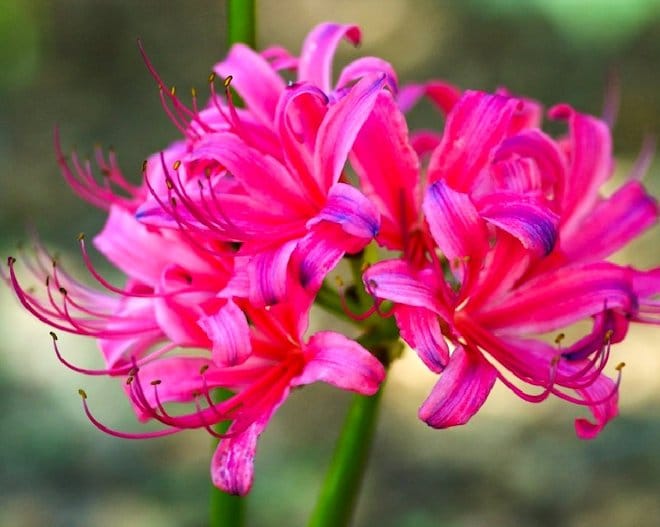

Preparing for winter
In late autumn, the dried flowers and leaves of the plant are removed. Bulbs are not dug up for the winter. With deep rooting, they are not afraid of frost, but only on condition that the distance from the bottom to the surface of the site is at least 30 cm. If forecasters promise a harsh winter without snow, the flower is covered with dry grass, leaves, spruce branches or agrospam until spring arrives.
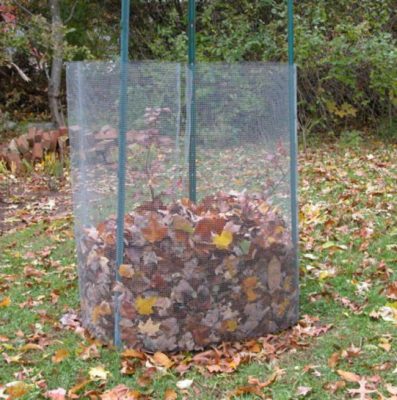

The flower does not really like the cold, so shelter does not hurt
Application in traditional medicine
Licorice is not an officially recognized medicinal plant. However, in many folk recipes of the East, the flower is used to eliminate phlegm when coughing.
In Russia, the plant is not used, since it is quite rare. In addition, the use of lycoris internally and externally can harm the body. This is due to the chemical composition of the plant parts. the fact is that the leaves and bulb of lycoris are poisonous. This condition limits the medicinal use of the spider lily.
Licorice care
- Watering... When watering, it is important not to overdo it, since lycoris does not tolerate stagnant water. In case of waterlogging, it is exposed to diseases, and may even die. Do not water the lycoris when the leaves dry up and the flowering is not over yet. Such changes in life indicate the beginning of a period of rest.
- Top dressing, fertilizers... Organic fertilizers are applied before planting lycoris. When the period of intensive plant growth comes, complex mineral fertilizers are applied.
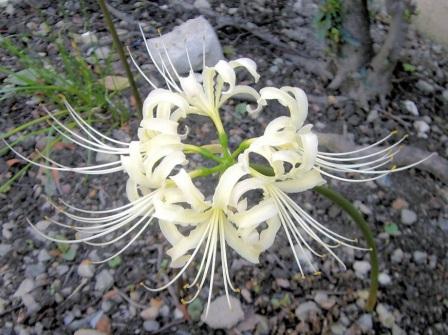

Licoris radiant - Lycoris radiata
Application in landscape design
Spider lily is a fairly common cultivated plant. However, it is not easy enough to find cultivated varieties of lycoris in their native lands. This condition is due to various legends that relate to the flower. In Asia, culture can only be found on cemetery land.
In Russia and other countries of the European part of the mainland, lycoris can be found in flower beds, parks, gardens and on balconies. Licoris has a decorative appearance, due to which it is appreciated by flower growers and lovers of unusual plants.
In gardens, the spider lily gets along easily with many other inhabitants of the flower bed. So, the plant looks spectacular against the background of tall bushes, and also creates an optimal background for undersized representatives of the flora. So, lycoris is usually planted along with flowers, the care of which is similar - begonia, crocus, daffodils and tulips. Also, the flower becomes a pleasant background for irises and dilfinarum.
The spider lily gives an unusual appearance to the garden or flower bed, since its flowers of irregular shape make you admire the plant for a long time. Simplicity in cultivation is also of great importance in the choice of culture.
Transfer
Licoris does not welcome transplants.He feels great in the same place for 5 years. After the specified period, experienced florists advise to transplant the culture.
To do this, you should select and prepare the right place, fertilize it with a substrate of peat, sand and humus (1: 1: 1) and transplant, observing the norms indicated above.


Important! Please note that all parts of the plant are poisonous, therefore, when in contact with it, you must thoroughly wash your hands. It is best to care for the crop with gloves.
The Legend of the Flower of Death
In the East, lycoris is considered to be a flower that is a symbol of misfortune and death. This is due to the legend. So, according to legend, two spirits of flora - Manzhu and Saga, who were in love with each other, took care of the lycoris. The first spirit was responsible for the flowering of the bush, and the second for the appearance of bright leaves. It so happened that two spirits forgot about the flower in order to meet each other. Then God decided to punish the disobedient by inventing a punishment for them - the spirits will be there, but they will never be able to see each other. So, lycoris first gives leaves, then discards them and buds appear on the flower.
Popular varieties in the photo
Most often, this flower is found in gardens in the south of Russia, less often in the middle lane. Florists prefer several varieties of the ghost flower.
- Licoris golden. It cannot tolerate temperatures below –5 ° C. It is often grown only at home. Its height is slightly more than half a meter. The diameter of the tubular canary-colored flowers is 10 cm. There are usually no more than 6 of them in the inflorescence. Blossoms in May or early June.


The height of the golden flower is about 60 cm
- Licoris blood red... Short in comparison with other varieties: only 45 cm. Tiny leaves grow from April to June. Scarlet flowers bloom in August. In the peduncle there are usually 5-6 buds with a diameter of 5 cm.


Lycoris sanguinea blooms at the very end of summer
- Licoris radiant. Highly decorative perennial with long filamentous stamens and unusual petals. The lateral "antennae" are bent back, and the central petals resemble a wavy arc. Large flowers are pink, white, terracotta (the color of fired clay). The height of the flower arrows reaches 30–70 cm.


Licoris radiant blooms for more than a month
- Licoris is scaly, or scaly. The coolest species with inflorescences of 8-9 buds. Funnel-shaped flowers smell good. The color of the petals slightly curved back is pale pink with a lilac tint, and the core is yellow. Plant height - 60–70 cm, it reproduces by daughter bulbs. Basal leaves appear at the end of the flowering period.


This variety can survive the winter without shelter.
Video: Licoris radiant in Japan
Main types of culture
For 2019, 20 species of lycoris have been registered. Only 4 species germinate in Russia:
| View | Description | Conditions and nuances of growing |
| Lycoris radiata - radiant lycoris | The massive leaf plates of the plant bend towards the edges. Large flowers are red, white and bright pink. The stamens are elongated. Height - from 30 to 70 cm. |
The rosette appears in the spring, and the flowers themselves bloom by the beginning of autumn.
Flowers bloom in mid-August.
The only caveat to planting is the soil. It should be well-drained and hydrated.
It grows outdoors in the southern regions of Russia.
One peduncle grows from 4 to 6 flowers. The flowers are large, poisonous yellow.
Flowering occurs in the second half of May or early June.
Licoris often becomes an inhabitant of the site and windowsill, due to its significant advantages:
- unpretentiousness, ease of care;
- there are practically no pest problems;
- lush bloom;
- multiplies rapidly.
Cultivation problems, pests
Licorice is resistant to diseases and all pests except daffodil flies. So that they do not harm, during the period of active growth, the flowers are watered with an insecticidal solution.
Licoris is poisonous, especially its bulbs. In order to comply with safety regulations, flower growers work with him only in thick rubber gloves. It is grown in a place inaccessible to children and pets.
If you do not follow the watering regime, root rot may appear due to excessive moisture in the soil. With prolonged exposure to direct sunlight, the leaves get burns: light, as if burnt out, areas. This is bad for both health and the outward appearance of the culture.
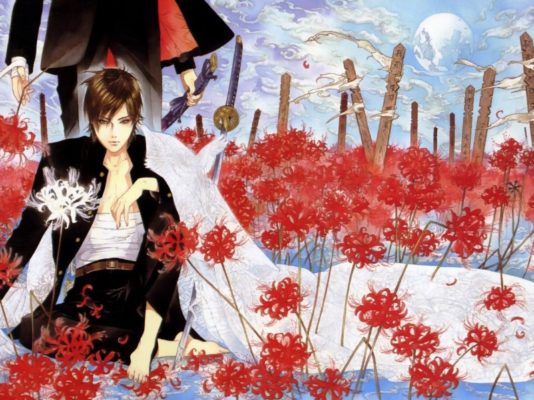

Higanbana - the flower of samurai honor and death in battle
Choosing a place for planting and preparing the soil
In nature, the flower grows in semi-shaded places, next to trees. He does not tolerate the scorching rays of the sun, or pitch shadow. It is also negatively affected by the wind, constant drafts.
The best place is a plot next to a fence, a building, or surrounded by other medium-sized shrubs and flowers.
At home, a flower should be placed on the west or east side.
The soil for a flower is ideally sandy, or slightly acidic with loose soil. The rich presence of humus guarantees a lush inflorescence. The flower substrate prefers light, composed of humus, foliage and turf in equal proportions.
Before planting, the soil is cleaned of grass, dug it up, leveled.
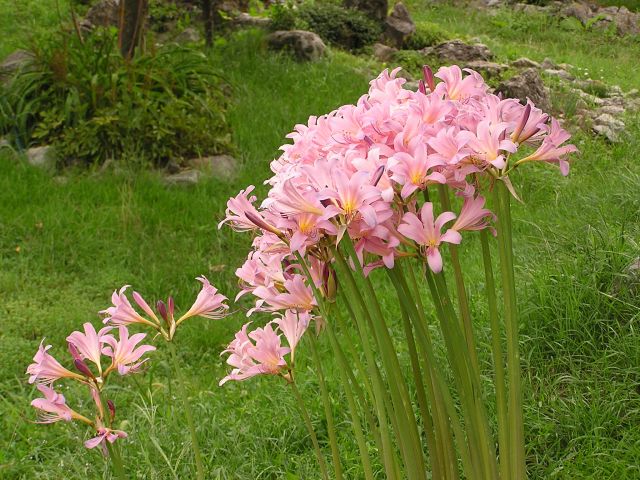

Landing dates
The landing should be carried out in mid or late October before the onset of frost, so that the lycoris has time to take root.
It can be planted in spring (mid-April), but the plant is likely to get sick often.
Japanese language of flowers
Japan is a distinctive and unique country. For centuries, it has developed in isolation from Western culture.
Surely Japan has its own language of flowers
based on ancient Japanese traditions. It is called
Hanakotoba
... Hana in Japanese means flowers, a symbol of life and love.
Hanakotoba
it is used not only in the preparation of bouquets of flowers. This flower language is deeply embedded in Japanese culture and tradition. Symbols
Hanakotoba
can be seen in many Japanese movies, cartoons, anime. For example, in the famous film
Takeshi Kitano "Fireworks"
(international film title
HANA-BI
:
HANA
- flowers,
BI
- the fire). Without knowledge
Hanakotoba
Western audiences find it difficult to understand this film.
And, of course, greeting cards in Japan should be chosen taking into account Hanakotoba
.
In this thread we will try to talk about the symbols of the Japanese language of flowers. Hanakotoba
... Some plants and flowers used in
Hanakotoba
, we practically do not know. They only grow in Japan and Southeast Asia. Therefore, it is possible
"Translation difficulties"
... As our great poet said:
". Forgive Shishkov, I don’t know how to translate ”.
Sakura
- kindness, politeness, nobility.
Chamomile
- faith, honesty, promise.
Cactus
- craving, lust, sex.
Morning glory
or
Morning glory
,
Morning glow
- deceptive promises.
Dahlia
- good taste.
Iris
- good news, good news.
Lotus
- to be away from your love, purity, chastity.
Yellow daffodil
, or
narcissist false
- respect.
Narcissus
- self-respect.
Hydrangea
- pride, self-esteem.
Chrysanthemum yellow
- imperial, supreme, majestic, magnificent.
The yellow chrysanthemum is the flower of the emperors. The 16-petal yellow chrysanthemum is depicted on the seal of the Emperor of Japan. The Order of the Chrysanthemum is one of the highest awards in Japan. Chrysanthemum is often depicted on Japanese coins and emblems. The chrysanthemum flower was a symbol of Japanese kamikaze pilots. Photo: Audrey.
Chrysanthemum white
- truth.
The four-leaf clover is a symbol of good luck not only in Japan, but also in almost all Western countries.
Reviews about the cultivation of lycoris
Like all bulbous, Licoris flaky is planted to a depth of 3 times the diameter of the bulb.Sunny or slightly shaded place, sandy loamy or loamy soil, rich in humus. Seed does not form, reproduces vegetatively.
Yuriks
Licoris can be not only white, yellow, red, it can be pink and blue, i.e. blue or light blue.
Elfey
Licorice in our conditions should be grown like nerins. Like many amaryllids, they do not like transplants, so they cannot be grown like gladioli. Moreover, you probably noticed that new leaves grow in them in late summer and autumn, and remain throughout the winter.
Nerina bowdena grows in my 10 liter container, after flowering I do not water it and put it in an unheated room at approx. + 5 degrees. until spring. Then the leaves begin to grow and you need light, watering and feeding. As soon as the weather permits, I take it out into the open air. And so it grows all season. At the end of July-August, I stop watering and feeding and put it under a canopy, arranging a dry period. It blooms in autumn. Licorice can be grown in the same way, but in winter their leaves do not die off, so they must be kept cool at maximum light and slightly moistened. The most persistent - the squamiger's lycoris - hibernates in zone 5.
Alik
Licoris is a beautiful plant with a stunning legend. In Japan, in the language of flowers, it means "looking forward to a new meeting." With proper care, it pleases gardeners for many years.
The lycoris flower (likoris) comes from the East, in its homeland there are legends around it, people believe that it has mythical properties. In Russia, gardeners grow licoris in their dachas and houses as an indoor flower. And he received the mythical name "flower of death" due to its frequent location near cemeteries.
In terms of agricultural technology, it is similar to tulips and daffodils, so caring for it is simple, subject to general recommendations. This is one of the main reasons why the choice is made in favor of lycoris.
Propagation of lycoris by bulbs
Most often, lycoris is propagated by daughter bulbs during transplantation. The seed method of reproduction is also possible, but it is more laborious. In addition, some species are infertile.
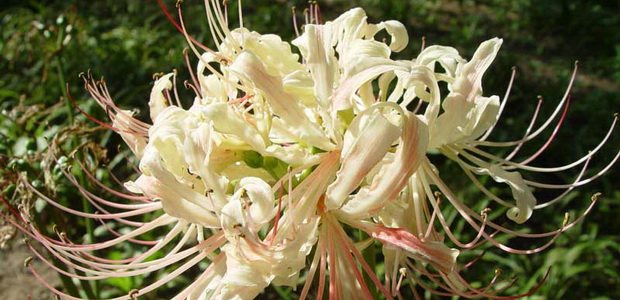

The bulbs are taken from an adult, healthy plant. This work is carried out in late autumn, when the children are mature enough and can grow on their own in a new place.
It is best to plant lycoris bulbs in late October - early November, so that they have time to take root and take root in a new place. It is believed that planting is possible in the spring. As practice shows, bulbs planted in spring do not adapt well and begin to rot.


Before planting, a site is selected and the soil is prepared. When planting, the distance from the bottom of the bulb to the surface of the ground should be about 30 cm. This will allow the bulb to successfully endure the winter without damage from severe frosts. It is necessary to leave a distance of at least 25 cm between the plants, since each bulb will form new babies every year, which will need space and nutrition.
Before placing the onion in the hole, a small layer of sand is poured on the bottom, after which the onion itself is placed and again covered with sand on top so that it completely hides it. Then the hole is covered with soil to the very top and the surface is tamped. A small amount of water is poured onto the landing site.
Growing in the garden
Caring for the exotic "flower of death" lycoris is not burdensome, and an inexperienced gardener will be able to grow this attractive plant. Agricultural engineering consists of the following activities:
- regular and abundant watering;
- periodic feeding;
- loosening;
- transplants;
- weed and pest control.
In the northern and central regions, plant care also includes preparing for the winter.
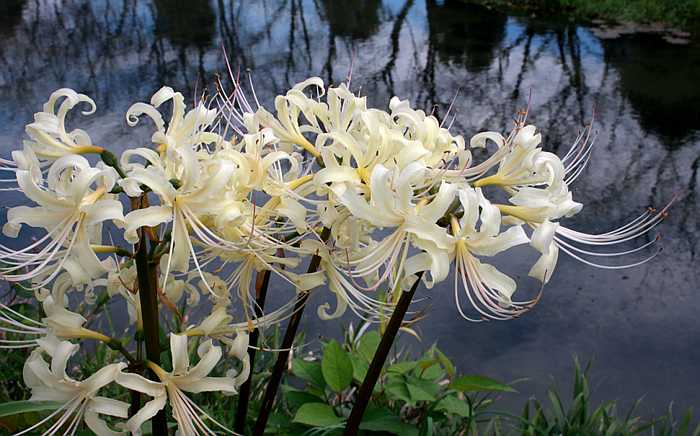

Spider lily lycoris for garden decoration
Licoris is not so common in the flower beds of Russian gardeners. In our country, this plant is currently considered rather exotic. It is grown mainly by connoisseurs of rare flowers.This culture is in perfect harmony with many other ornamental plants in the garden, and is also suitable for creating bright, spectacular compositions. The best neighbors for her will be low-growing flowers with similar requirements for growing conditions. However, you can deviate from this rule and plant licoris next to hosts, anemones, crocuses, begonias, irises, delphiniums, ferns and many other plants. The main thing is not to stop experimenting, then it will turn out to create a unique ensemble.
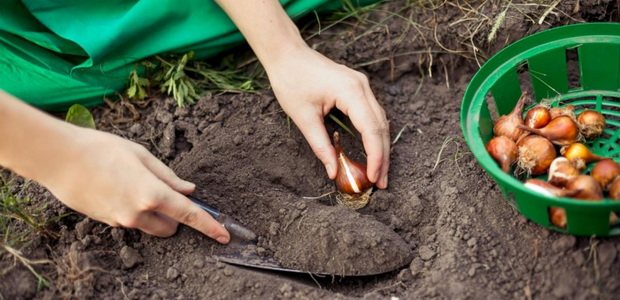

When planting licoris, you need to remember that its leaves never meet with flowers. Large beautiful foliage is formed in early spring, and dies off by mid-summer.
An exotic flower is best suited for drawing up flower beds, creating mixborders, decorating borders. Having planted several copies in one place, you can get a lush carpet in any corner of the garden. This is especially true if you need to fill in the semi-shaded corners of the site, where not every ornamental plant will take root.
It is an excellent crop for cutting and forcing.
To see how a lycoris flower looks on a personal plot, a selection of photos below will help, where compositions with this perennial of different complexity are demonstrated:
Flowering features
Lunnik flower - annual and perennial plant species
At the beginning of autumn, the bulbs of the culture throw out peduncles, which in just a few days reach a height of 40-50 cm. On the peduncles, one by one, funnel-shaped flowers with a large number of stamens begin to open. Flowering lasts about 11-14 days. Once this process is complete, foliage blooms on the spider lilies, which does not dry out even during the cold winter months. Leaf plates die in early summer, before flowering begins.
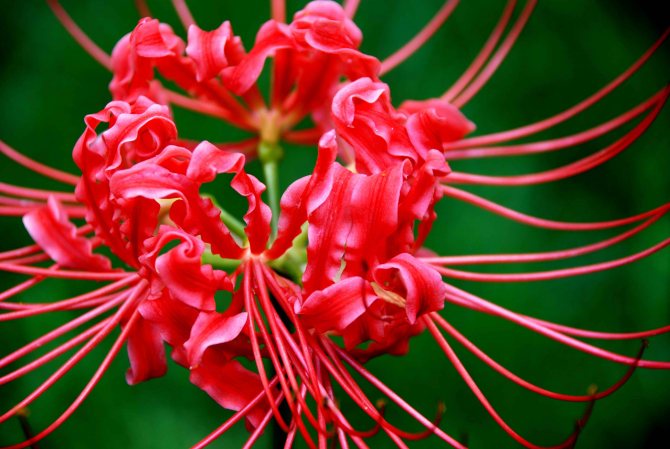

Mystical plant

